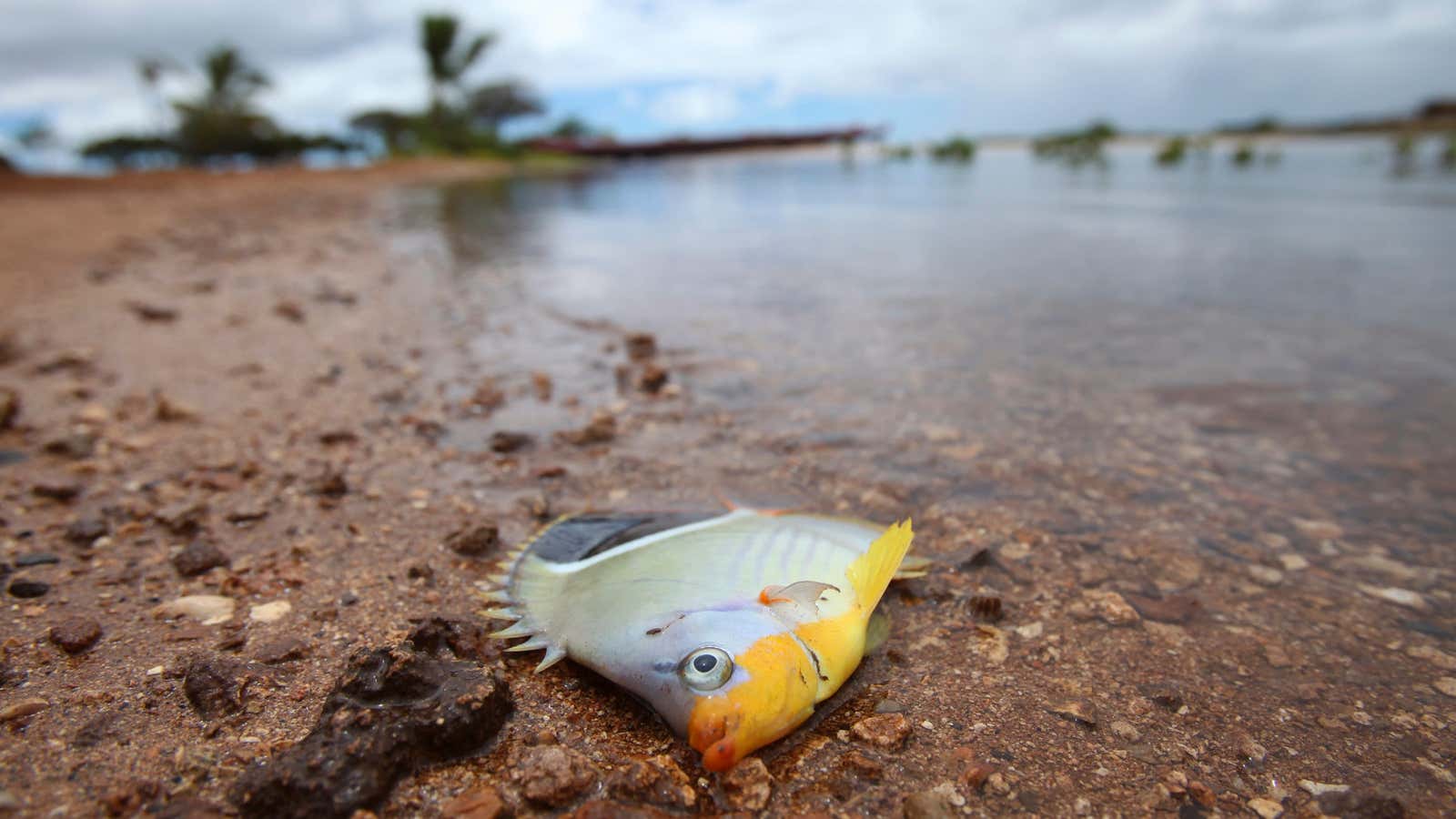Thousands of fish—gasping desperately, then floating lifelessly—surfaced in Honolulu Harbor this week, suffering from oxygen deprivation caused by a massive molasses spill. This strange case of sugary suffocation was brought on by the Matson Shipping Company, which was loading one of its vessels with 1,600 tons of molasses through a pipeline in the harbor early Monday morning when a leak sprung. Matson reported that up to 1,400 tons of the sludgy syrup may have escaped into the harbor and nearby Ke’ehi Lagoon.
There is no way to clean up a molasses spill. “It’s sunk to the bottom of the harbor,” Matson spokesman Jeff Hull told the L.A. Times on Wednesday. There, the molasses has displaced the oxygen-containing seawater that thousands of marine organisms rely on to breathe.
Hawaii News Now reported the devastating ecological impact of the spill with an underwater video recording this afternoon. In the words of Roger White, the scuba diver who shot the video, “It was shocking because the entire bottom is covered with dead fish.”
The Hawaii Department of Health, rather than the US Coast Guard or Environmental Protection Agency, is responding to the accident because it is not an oil or “hazardous material” spill, according to NOAA’s Office of Response and Restoration. It doesn’t really matter who gets involved, because there isn’t much mitigating to be done. Officials are currently monitoring water quality in the harbor, collecting dead fish (lest they attract hungry sharks and eels), and urging residents to stay out of the water.
When an oil spill occurs, a large oil slick forms on the water’s surface, and emergency response efforts often focus on dispersing that oil away from the surface and down through the water column, where the oil becomes less concentrated and, consequently, less threatening to marine life. This only works if the water is sufficiently deep, though; the NOAA OR&R website says, “To avoid contaminating the sea floor, most dispersant use to date has been restricted to waters deeper than 10 meters (about 30 feet).” The waters of Honolulu Harbor are just about that deep, but no matter, because molasses behaves very differently from oil. Unlike oil, molasses sinks, and now 1,400 tons of it, highly concentrated, are bearing down on the sea floor off the coast of Oahu.
Estimates on how long it will take the molasses to disperse on its own and eventually “flush out” of the harbor vary. Gary Gill, from the Hawaii Department of Health, said he hoped that the tides would clean out the harbor “over the next couple days.” NOAA said “a week or longer,” and Hawaii News Now quoted a local marine science expert who simply said it would take “a long time.” Tidal currents in the area are generally weak.
Elizabeth Miles, who has lived on a sailboat at Honolulu’s La Mariana marina for the past six years, told me “these fish are like part of the family” for all the residents of the 90 boats there, “and [Ke’ehi] lagoon is our backyard.”
The Hawaii health department said in a statement that the molasses could also cause “an unusual growth in marine algae… an increase in harmful bacteria… and other environmental impacts.” On Thursday morning, Miles noticed a change in the water around her home: “There’s some sort of new slimy algae stringy filmy growth that’s starting to cover the surface. I suppose that has something to do with the nutrients in the molasses.”
Another Matson molasses spill occurred 10 years ago in Maui, but that was in December, when winter storm conditions contributed to flushing the water, and the contributing pipeline leak was identified and stopped relatively quickly, so only about 50,000 gallons of molasses escaped into the water. The 1,400 ton estimate of the Honolulu spill equates to over 200,000 gallons.
“We’re all devastated,” Miles said. “I mean, it’s not a clean area, because it’s a lagoon, but we can usually see the bottoms of our keels and the water is turquoise… and now it’s black. It’s going to be black for a long time, I think.”
The originally appeared at The Atlantic. More from our sister site:
Is the air quality in Beijing worse than Ground Zero’s after 9/11?
